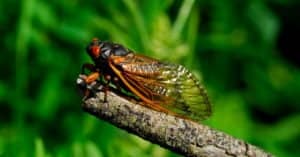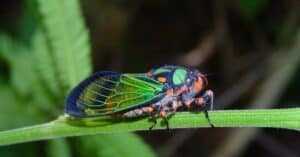
You may be familiar with the noisy “song” of the cicada. These large insects make a buzzing-chirping sound to attract females during mating season. Most cicadas are in the 1-2-inch range, but a few can be more than 2 inches long! In North America, periodic cicadas emerge from the soil on a 13- or 17-year cycle based on where they live.
Scientists have been studying these cicadas for years and have labeled each group to predict their next emergence. Periodic cicadas are usually around 1.5 inches long. Annual cicadas live between 2-5 years and new generations emerge every year. Annual cicadas live all over the world except for Antarctica and other locations where it is too cold. Let’s take a look at some of the largest cicadas in the world. While these are not necessarily ranked in order, these are all cicadas that can get to be more than 2 inches long!
Empress Cicada (Megapomponia imperatoria)
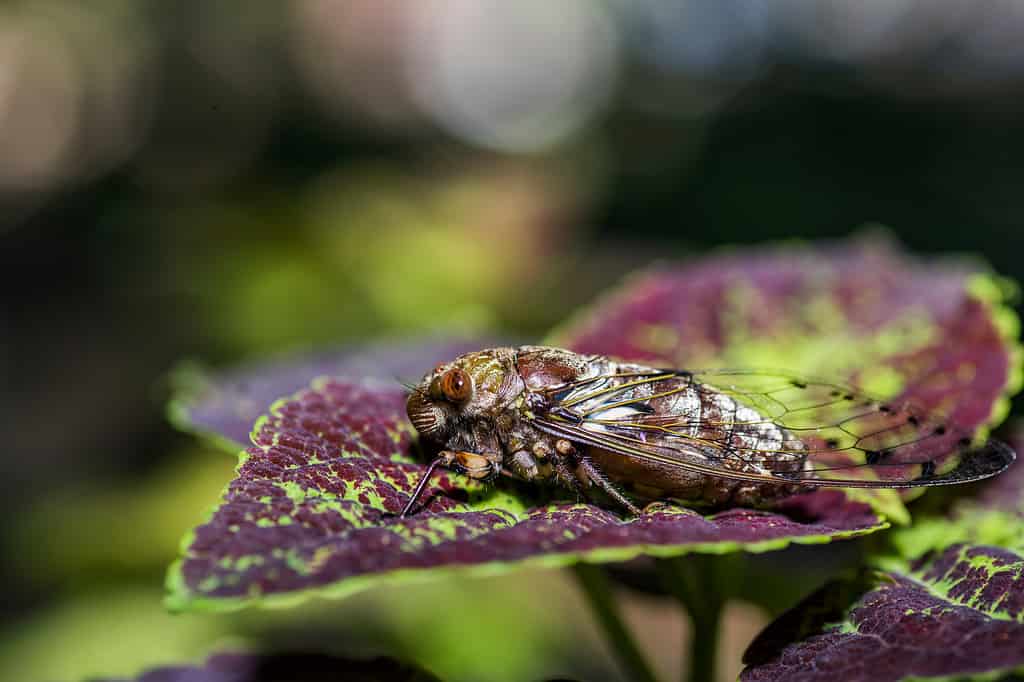
An empress cicada, or Megapomponia imperatoria, the largest species of cicada.
©MEMBERHS/Shutterstock.com
The largest cicada in the world is the empress cicada (Megapomponia Imperatoria). These impressive insects can have a body that is up to 2.8 inches long plus a wing span of 7-8 inches! For comparison, a credit card is about 3.375 inches long, so their bodies are a tad shorter than that. Their wing span, though, is more than two credit cards long! Cicadas are characterized by opaque membranous wings and big round eyes that stick out from their heads. There are more than 3,000 different species of cicada. The empress cicadas are found in Malaysia which is in Southeast Asia. Some Malaysians refer to these giant noisy insects as the “six o’clock cicada” due to their chorus of loud chirping that begins at sunset.
Northern Dusk-Singing Cicada (Megatibicen auletes)

A northern dusk-singing cicada, or Megatibicen auletes.
©Books Beans and Beads/Shutterstock.com
The largest cicada in North America is the Northern dusk-singing cicada. These cicadas have a body that ranges between 2.25-2.75 inches. Their bodies can either be olive green or reddish brown, and the veins in the clear wings are very pronounced. Some describe them as being dusted in powdered sugar with a white-waxy substance on their bodies. They can be found in the United States in the southern states of Georgia, Alabama, Mississippi, and northern Florida, as well as South Carolina, North Carolina, Virginia, Tennessee, and Kentucky. The songs of this cicada can sound very similar to other cicada species. While all cicada songs might sound similar to an untrained ear, studies have shown that each species has a unique song.
Emperor Cicada (Tacua speciose)
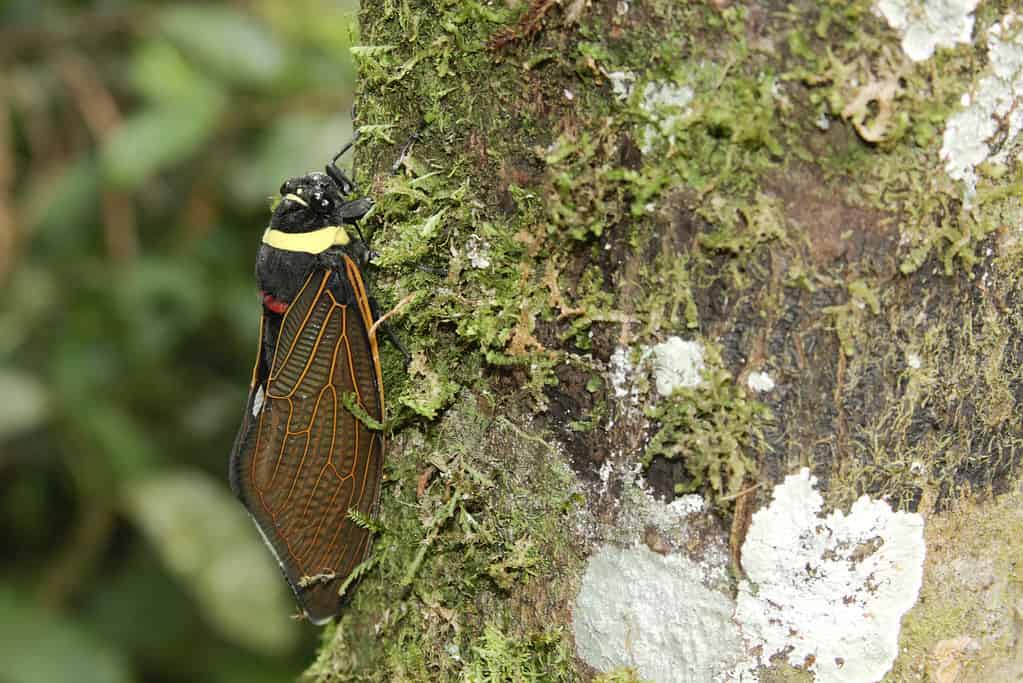
An emperor cicada, or Tacua speciosa.
©Bildagentur Zoonar GmbH/Shutterstock.com
The emperor cicada (Tacua speciose) is a large cicada that has a unique coloration. Their scientific name Tacua speciose comes from the Latin word “speciose” for beautiful. These cicadas have a yellow-to-green collar around their necks, a red marking midway down their backs, and a light greenish band near their ends. While some cicadas’ wings are clear or colorless except for the veins, the emperor cicada has dark grayish-brown wings. Most emperor cicadas fall in the 1.9-2.2-inch range with a wingspan of 5.9-7.1 inches. Like other cicadas, they are not skinny like a grasshopper, as they have wide bodies that can get to be wider than an average finger. Emperor cicadas are from Malaysia, Indonesia, Borneo and Sumatra.
Large Brown Cicada (Graptopsaltria nigrofuscata)
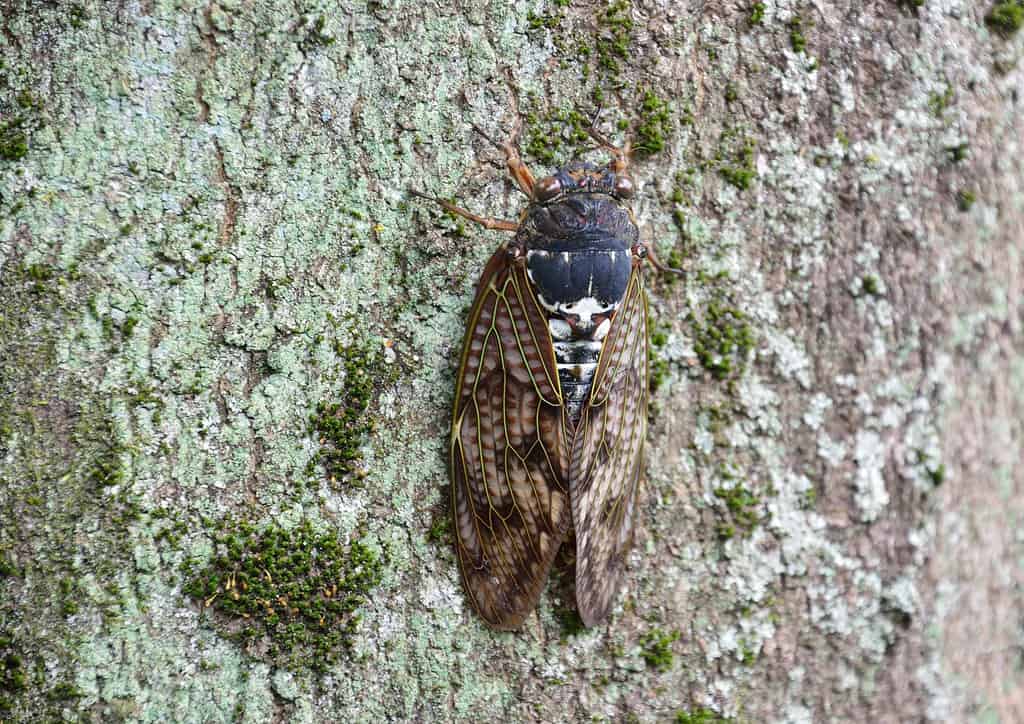
A large brown cicada, or Graptopsaltria nigrofuscata.
©High Mountain/Shutterstock.com
A cicada with a pretty straightforward name is the large brown cicada. These Japanese cicadas are also called Abura-zemi in Japan. Besides Japan, you can find them in Korea and parts of China. As their name implies, they are good-sized cicadas (2.2-2.4 inches), with brown bodies and a molted brown pattern on their wings. They camouflage nicely with tree bark; however, when the males make their loud chirping, they are a dead giveaway!
Cicada males have a tymbal organ that they can use to bend and snap the membrane on their abdomen. Doing this repeatedly a hundred-plus times a second creates the constant buzzing noise we hear. The sound of the cicada is amplified even more by the tiny air sacs they have. Did you know their sound can reach 90 decibels or more? The loudest cicada is the African cicada (Brevisana brevis) which can reach decibels of 106.7. Imagine a whole brood singing together…now you can understand why they might be a nuisance!
Giant Cicada (Quesada gigas)
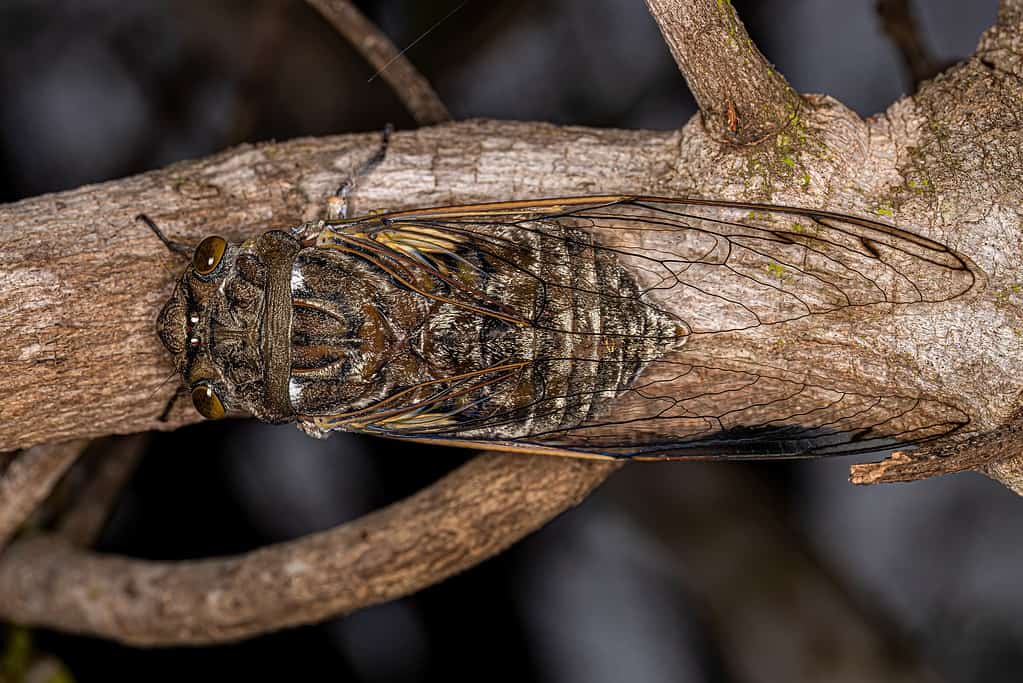
The giant cicada
©Vinicius R. Souza/Shutterstock.com
Another cicada with an obvious name is the giant cicada. These cicadas are found mostly in Central and South America but the northern range does reach as far north as Mexico and spills over a bit into the United States in Texas. The southern range reaches all the way down to Argentina. The giant cicada has one of the largest ranges for cicadas and what is remarkable is their songs are the same across the whole range! Again, it may take a trained ear to tell the difference, but researchers continue to study just how these insects communicate.
The giant cicada is a mix of brown, green, and black, with clear wings with black wing veins. Their bodies are 2-2.25 inches long and when resting, their wings jut out past the end of their bodies. They have two large, reddish brown eyes sticking out from the side of their head and six stick-like legs. While cicadas usually live in wooded areas and forests, they can end up in rural, suburban, and urban areas where their loud songs do impact the humans that live there.
Fun Fact
The largest collection of cicadas is kept at The National Museum of Natural History in Washington D.C. Entomologist & Collections Manager Dr. Floyd Shockley says they have samples of nearly 2,500 different species. He says they are studying the cicada from different locations to monitor things like climate change and other changes in the environment. They are studying cicadas from different locations to compare the similarities and differences in the species. Evolution wise the cicadas today are extremely similar to the same ones nearly four million years ago. Remarkable creatures for sure!
Summary Of The 5 Largest Cicadas In The World
| Rank | Cicada | Size | Location |
|---|---|---|---|
| 1 | Empress Cicada | up to 2.8 inches long with a wing span of 7-8 inches | Malaysia |
| 2 | Northern Dusk-Singing Cicada | between 2.25-2.75 inches | United States |
| 3 | Emperor Cicada | between 1.9-2.2 inches with a wingspan of 5.9-7.1 inches | Malaysia, Indonesia, Borneo and Sumatra |
| 4 | Large Brown Cicada | 2.2-2.4 inches | Japan, Korea and China |
| 5 | Giant Cicada | between 2-2.25 inches | Central and South America, parts of Texas |
The photo featured at the top of this post is © Books Beans and Beads/Shutterstock.com
Thank you for reading! Have some feedback for us? Contact the AZ Animals editorial team.



